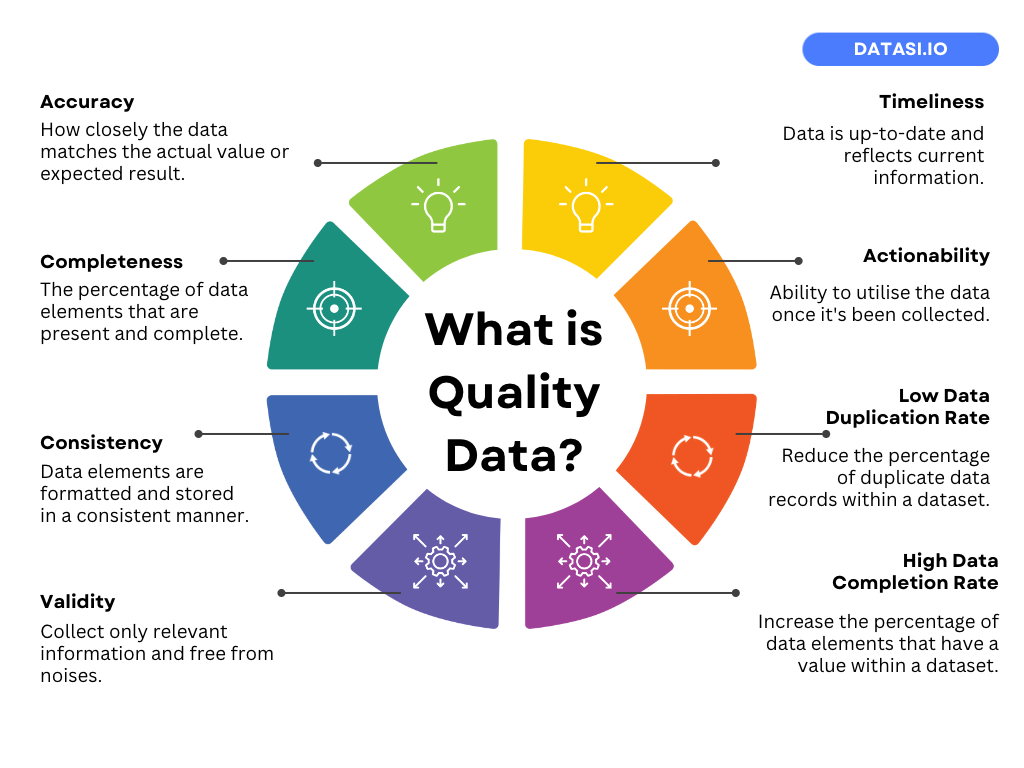In the computer science and mathematics domain, there is a term called GIGO.
The abbreviation stands for garbage in, garbage out.
It highlights the importance of input quality for obtaining reliable output.
This concept holds true in the context of data utilization as well.
While many companies focus on data collection and cutting-edge analysis tools, they often overlook the fundamental aspect of data quality and its significance in generating valuable insights for decision-making.
Poor-quality data can lead to disastrous and costly outcomes for businesses, with IBM estimating that the cost of such data in the US alone amounted to $3.1 trillion in 2016.
Most of these costs are hidden and unnoticed by the companies. Cost can come from:
- Making erroneous decisions from wrong insights
- The time cost of analyzing flawed data
- Organizational inefficiencies or low productivity
- Potential harm in relationships from making wrong decisions including relationships with customers, suppliers, and employees.
- Opportunity costs, including the inability to innovate
- Compliance costs or fines
- Reputational costs
- Scrap and rework
- Additional workarounds and hidden correction processes
To ensure data can generate continuous value for the company and be trusted by all stakeholders, data quality needs to be given enough attention.
In today’s post, we want to talk about how you can collect quality data and maintain high data quality standards within your company.
What is Data Quality?
Data qualityis a measure of the condition of data based on the following 8 dimensions:
- Accuracy
- Completeness
- Consistency
- Validity
- Timeliness
- Actionability
- Low data duplication rate
- High data completion rate

To ensure reliable and valuable data for analysis and storage in databases, adherence to these standards is crucial.
Accuracy, completeness, and consistency take precedence in data collection, ensuring that analytical insights accurately reflect the complete business landscape and provide a reliable basis for decision-making.
Why is Data Quality Important for Your Business?
As mentioned above, using poor-quality data can result in significant costs for businesses.
In the process of gradually transforming your enterprise into a data-driven company, you need to ensure that you have laid a stable data foundation, that is, a complete and systematic data management program. This program ensures that the data being used is of high quality and can be trusted by all stakeholders.
With high-quality data, members of your organization can safely trust the data for usage, which can greatly lead to increased productivity, reduced risks, more accurate decision-making, and competitive advantage through valuable insights into customers, products, and opportunities.
Best Practices for Collecting High-Quality Data
Collecting quality data requires establishing standards and following systematic procedures throughout the data lifecycle. It requires the consistent efforts of all team members to build quality into processes and actions.
The following steps are crucial in collecting high-quality data:
1. Clarify Objectives
Before initiating data collection, clearly define your objectives and business goals. What do you aim to achieve with the data?
Identify both short-term and long-term goals, and foster strategic collaboration between business and IT departments.

It’s best to focus on a few key metrics (preferably below 5) for now that are directly aligned with your business goals.
A way for you to narrow down the goal is to ask yourself, is this goal a direct indicator of my business goal, or just another vanity metric?
Vanity metrics are the metrics that can make you feel good, boost your vanity, and provide superficial satisfaction but lack actionable insights.
For example, if you want to analyze your website or app’s performance, instead of measuring the total number of registered users, focus on the percentage of active users to gain meaningful insights into user engagement.
Do not be too ambitious at this stage to collect all the data as possible, as this will lead you having mental fatigue and decision paralysis in the later part of the data cycle.
2. Select Appropriate Tools and Techniques
After you have decided on what metrics you want to collect, you will now think of what are the different tools or techniques you can use to collect this data.
Different types of data require different methods of data collection. You might also need to engage different experts (technical, data expert, etc.) to help you with different data collection and storage.
It’s important to formulate questions around the metrics you are going to collect. For instance, are you collecting qualitative data or quantitative data?
Qualitative data are information that can’t be counted or is not numerical. Some forms of qualitative data include text, audio, and images. While quantitative data are those with numerical input. They would require a different design for data collection.
Some ways to collect data include internal data collection by implementing tracking with technical integration. If you want to understand your user’s behavior on your website or app, you can integrate by having a code on your page to track your user’s behavior.
Google Analytics is a commonly used web analytics service offered by Google that tracks and reports website traffic including your website users’ demographic information and behavioral data.
Whenever a user performs a behavioral operation, this operation will be collected by the code behind the corresponding page location. The reported data then will enter the data warehouse through a series of processing procedures, forming massive user data. You are able to view the data in a dashboard through Google Analytics.
Data that can be tracked through the website/App includes the user’s device information, software abilities, data permission, and all behavior activities on the website or app.
Google Analytics can be the handiest tool when comes to web page analytics, but if you are also using other platforms to collect user data, you may want to store them in a centralized location for management and viewing.
A centralized dashboard can increase your efficiency in handling the data and gaining insights, acting as one source of truth for the whole team.

Talk to us today
Find out how we can help your business to build a successful data strategy.
3. Establish Data Collection Processes
It’s important to set up a robust governance plan from the start to ensure the data quality and standards are maintained within your team.
Data governance involves setting internal policies and standards for data collection, processing, and storage.
This ensures consistent adherence to guidelines and protocols by all data collection personnel. Key practices include:
1. Establishing Guidelines
Developing clear and concise data collection guidelines that specify what data to collect, how to collect it, and the required data quality criteria.

2. Use Standardized Forms or Templates
Using standardized forms or templates to ensure consistent data collection across all sources.
3. Establish Data Entry Procedures
Implementing clear procedures for entering data into databases or spreadsheets, including double-checking for errors and verifying data quality criteria.
4. Implement Data Quality Checks
Employing data quality checks, such as data validation scripts, to ensure accuracy and structure before utilizing the data.
Data validation is the practice of checking the accuracy and structure of the data before using it.
We will discuss data validation in detail in future posts. Do not miss any data insights by subscribing to our newsletter below.

[mailerlite_form form_id=3]
5. Monitor Data Quality
Regularly monitoring data quality to identify and rectify any issues or errors and ensure compliance with established quality criteria.
If you are collecting data through questionnaires or surveys, you should also involve a professional to avoid any bias in question design and ensure proper sampling procedures are followed.
4. Report and Manage Collected Data
Lastly, plan how the collected data is being reported. For instance, based on the size and volume of the data collected, do you want the data to be stored in a database or integrated directly with a Business Intelligence (BI) tool?
Depending on the chosen approach, data may need to be cleaned and formatted appropriately. Technical expertise or professional assistance may be necessary for these tasks.
Conclusion
The importance of data quality cannot be overstated in today’s data-driven business landscape. Poor-quality data can lead to costly mistakes and missed opportunities, while high-quality data can drive informed decision-making and provide a competitive advantage. By following best practices for collecting and managing data, you can be assured of the reliability and value of your data assets.
To establish a solid data management strategy tailored to your business needs, it’s crucial to have a comprehensive understanding of data quality dimensions and implement standardized procedures.
At DataSI, we specialize in helping businesses develop sustainable data management strategies. Our experts can guide you through the process, assisting you in planning a data roadmap from scratch and building a solid data foundation. If you’re ready to unlock the full potential of your data and enhance your decision-making capabilities, we invite you to schedule a one-on-one consultation with one of our data experts.
Remember, the quality of your data sets the stage for success in the data-driven era. Don’t miss out on the valuable insights and competitive advantage that high-quality data can provide.

Talk to us today
Find out how we can help your business to build a successful data strategy.


